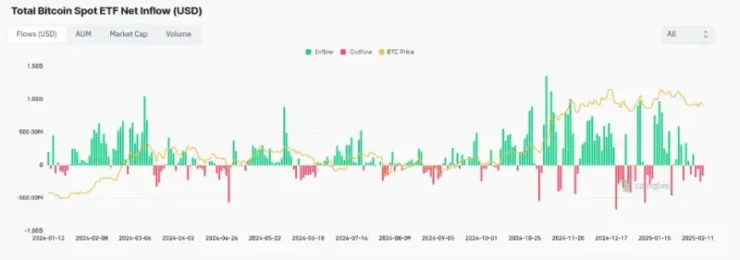President Donald Trump signed a memorandum on Thursday, pausing the implementation of reciprocal tariffs originally scheduled to go into effect this week. The move offered momentary relief to Bitcoin and the broader cryptocurrency market, which had been experiencing declines in anticipation of the new trade measures. However, with tariffs now expected to take effect in April, investor sentiment remains fragile.
Trump’s directive tasks Secretary of Commerce Howard Lutnick and other administration officials with crafting a strategy to impose reciprocal tariffs on countries that tax U.S. imports. “On trade, I have decided for purposes of fairness, that I will charge a reciprocal tariff, meaning whatever countries charge the United States of America, we will charge them,” Trump stated from the Oval Office.
The latest move follows Trump’s imposition of a 25% tariff on all imports of steel and aluminum into the U.S., a decision that has escalated tensions with key trading partners. Duties on Chinese goods took effect last week, prompting retaliatory measures from Beijing. Trump has also warned that further tariffs may be imposed on the European Union and India in the coming months.
While the announcement temporarily halted the crypto market’s downturn, experts suggest that the sector remains closely tied to macroeconomic developments. Bitcoin (BTC) dropped from over $98,000 to $95,000 during the Asian trading session before rebounding to $96,000 following the news. Nevertheless, with tariffs likely commencing in the second quarter, investors appear hesitant to reallocate capital into digital assets.
Bitcoin ETFs and Institutional Flows Signal Market Caution

Despite the brief recovery, Bitcoin exchange-traded funds (ETFs) have faced consecutive days of net outflows, reflecting a cautious stance among institutional investors. According to data from Farside, these investment products have registered a four-day cumulative outflow of approximately $680 million, reinforcing concerns over the crypto market’s increasing correlation with broader economic trend.
Data from Farside showing Bitcoin Outflows. Source: Farside
The recent turbulence follows a period of heightened volatility in the crypto sector, which saw a significant downturn between February 2-3. During that period, a sharp crash erased over $2 billion from the crypto derivatives market, exacerbating investor unease. Analysts suggest that macroeconomic uncertainty, including trade policies and inflation concerns, continues to shape crypto price movements.
Tariff Impacts on Global Markets and Crypto Correlations
Earlier this month, Trump’s initial tariff announcement sent shockwaves across financial markets, leading to a decline in major cryptocurrencies, including Bitcoin and Ethereum. The price of Bitcoin plummeted from $105,000 to $92,000 following the news, only to rebound above $100,000 after Trump paused tariffs on Mexican and Canadian goods.
However, with U.S. tariffs on Chinese imports still set to take effect, uncertainty looms over global markets. Trump has hinted at additional measures against the European Union, further raising concerns over potential disruptions to international trade and financial stability. Japan has also opened diplomatic discussions with Washington to assess the impact of the reciprocal tariffs, reflecting growing global apprehension.
Trump has reaffirmed that there will be no exemptions for companies affected by the tariffs, including Apple. “In the case of Apple, I gave them a waiver in my first term because Samsung was in South Korea and didn’t have to pay the tax,” Trump told reporters. “But now this applies to everybody across the board.”
While Bitcoin and other cryptocurrencies have historically been viewed as decentralized assets independent of traditional economic forces, recent trends suggest a growing susceptibility to macroeconomic pressures. Market participants will closely watch upcoming economic data and geopolitical developments to assess whether cryptocurrencies can decouple from broader financial trends or remain tethered to policy shifts in Washington.





